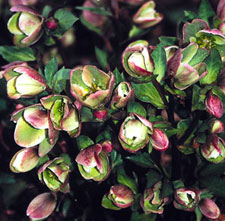
'Ivory Prince' hellebores bloom for weeks in very early spring. (Photo courtesy of Plant Delights Nursery.)
Change is the air — literally. As the seasons shift and winter gives way to spring, it's time to assess and evaluate. In the garden, this may mean planning a complete renovation. Gardens are not static museum pieces. Your space should reflect you, and you are not stagnant. Your inspirations and motivations change, and so should your gardens.
Spring is the perfect time for a garden makeover. Light intensity and soil temperatures encourage plant growth, pests and diseases are minimal, plants and materials are easily available from well-stocked nurseries. And, most importantly, after being cooped up for a few months, you are brimming with energy and ideas.
After such a snowy winter, I'm certainly ready to get out and start updating my garden. The benches and raised beds need repair, some plants need to be divided and others replaced. Most importantly, I've changed. My knowledge of gardening and my design style, favorite plants, and even my reasons for gardening have all shifted in the last decade. The garden design was perfect for my tastes and skill level at the time. But now, like my ten-year-old Guess jeans, it's not a good fit anymore.
You don't have to wait ten years to redo your garden. If your preferences and knowledge radically change, revamp your garden regardless of its age. Remember, you should be happy and interested every time you visit your garden.
Don't feel obligated to keep old plants, artwork, or other design elements. Your garden is not a nature preserve or wildlife sanctuary. Feel free to move or remove anything. If a path needs to be wider, expand it. If you no longer like gazing balls, take them out and replace them with a nice shrub or statuary that you like better. This can be difficult to do with plants. Sometimes we can take our role as plant caretakers a little too seriously.

Annual vines like morning glory quickly scale trellises and fences to add height to the garden and screen unwanted views.
For years I kept an underperforming Kamchatka bugbane (Actaea simplex) in a prominent spot. It bothered me every time I entered the garden and saw various beautiful wildflowers and fascinating hellebores surround this pitiful bugbane. But I left it in place for all the wrong reasons: sense of duty, cost, and ego. I felt it was my duty to nurse the Asian woodlander to its full glory, especially after paying $60. Plus, pulling the plant out would be an admission of a costly mistake, and my ego wasn't ready for that.
Eventually, I replaced the bugbane with a couple of 'Ivory Prince' hellebores, which compliment the other plantings and make the entire area a joy. Since then, in my garden, I have been a gardener not a conservation biologist.
When the garden works for us, we want to work for it. If the plants or design don't fit, then don't put your energy into maintaining them. Instead, focus your efforts on creating a garden that inspires you to visit and stay awhile.
After your makeover, donate any leftover plants or materials to friends, schools, and/or churches. They will appreciate the gift and you will get the satisfaction of sharing a piece of your garden throughout the community. (However, don't give them your aggressive, weedy plants like goutweed and wild goldenrod.) The arrival of warmer weather is the perfect signal to transform your space into a garden that reflects your personality and progress. Happy gardening!